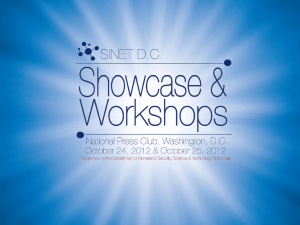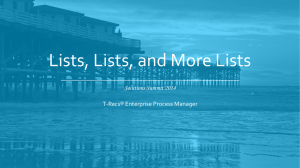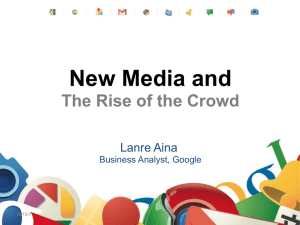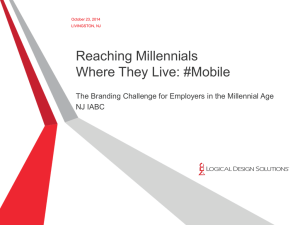AIA
advertisement
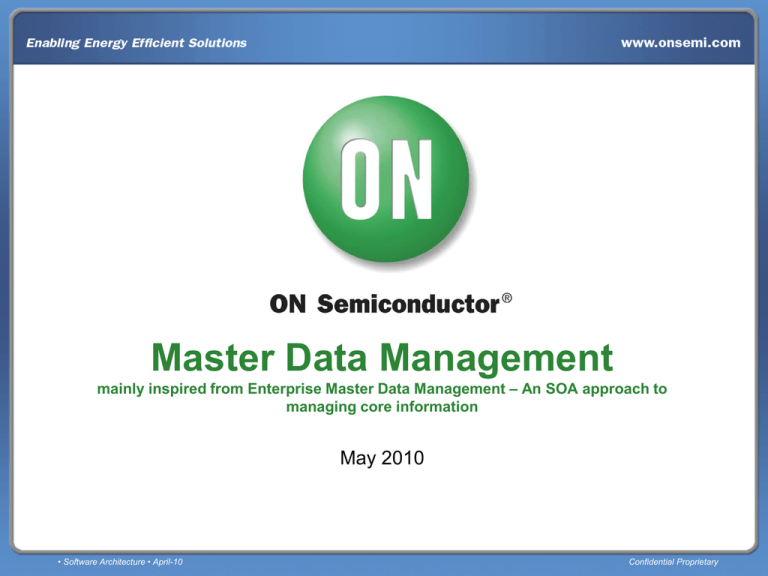
Master Data Management mainly inspired from Enterprise Master Data Management – An SOA approach to managing core information May 2010 • Software Architecture • April-10 Confidential Proprietary Table of Contents • Architectural Goals and Principles • MDM Reference Architecture • Conceptual Architecture • Logical Architecture • Component Model • Master Data Management Component Interaction Diagram • Collaborative Authoring • Operational Scenario – Transactional Interceptors for Updates • Operational Scenario – Federated Query • Coexistence Scenario – Information Synchronization • Distribution of Updates via Batch Processing • Data Governance • Incremental Updates to a Data Warehouse Confidential Proprietary Architectural Goals and Principles • The Master Data Management Solution should provide the ability to decouple information from enterprise applications and processes to make it available as a strategic asset for use by ON. • The Master Data Management Solution should provide ON with an authoritative source for master data that manages information integrity and controls the distribution of master data across the enterprise in a standardized way that enables reuse. • The Master Data Management Solution should be based upon an architectural framework and reusable services that can leverage existing technologies within the enterprise. • The Master Data Management Solution should be based upon industry-accepted open computing standards to support the use of multiple technologies and techniques for interoperability with systems in the enterprise and the extended enterprise. • The Master Data Management Solution should provide the flexibility to accommodate changes to master data schema, business requirements, and regulations, and to support the addition of new master data • The Master Data Management Solution should be designed with the highest regard for preserving the ownership of data, the integrity, and the security of the data from the time it is entered into the system until retention of the data is no longer required. • The Master Data Management Solution should provide the ability to incrementally implement a Master Data Management Solution so that a Master Data Management Solution can demonstrate “immediate value.” Confidential Proprietary Table of Contents • Architectural Goals and Principles • MDM Reference Architecture • Conceptual Architecture • Logical Architecture • Component Model • Master Data Management Component Interaction Diagram • Collaborative Authoring • Operational Scenario – Transactional Interceptors for Updates • Operational Scenario – Federated Query • Coexistence Scenario – Information Synchronization • Distribution of Updates via Batch Processing • Data Governance • Incremental Updates to a Data Warehouse Confidential Proprietary MDM Reference Architecture Conceptual Level Conceptual Architecture Logical Level Component Model Physical Level Operational Model Confidential Proprietary Functional Aspects Logical Architecture Table of Contents • Architectural Goals and Principles • MDM Reference Architecture • Conceptual Architecture • Logical Architecture • Component Model • Master Data Management Component Interaction Diagram • Collaborative Authoring • Operational Scenario – Transactional Interceptors for Updates • Operational Scenario – Federated Query • Coexistence Scenario – Information Synchronization • Distribution of Updates via Batch Processing • Data Governance • Incremental Updates to a Data Warehouse Confidential Proprietary Conceptual Architecture Presentation Integration Process Manager Confidential Proprietary Table of Contents • Architectural Goals and Principles • MDM Reference Architecture • Conceptual Architecture • Logical Architecture • Component Model • Master Data Management Component Interaction Diagram • Collaborative Authoring • Operational Scenario – Transactional Interceptors for Updates • Operational Scenario – Federated Query • Coexistence Scenario – Information Synchronization • Distribution of Updates via Batch Processing • Data Governance • Incremental Updates to a Data Warehouse Confidential Proprietary Logical Architecture External Data Providers Internal Participants LOB User Interface Analytics Dashboards Confidential Proprietary Legacy, ERP, Supply Chain, CRM, etc. (Adapters) LOB Systems: Table of Contents • Architectural Goals and Principles • MDM Reference Architecture • Conceptual Architecture • Logical Architecture • Component Model • Master Data Management Component Interaction Diagram • Collaborative Authoring • Operational Scenario – Transactional Interceptors for Updates • Operational Scenario – Federated Query • Coexistence Scenario – Information Synchronization • Distribution of Updates via Batch Processing • Data Governance • Incremental Updates to a Data Warehouse Confidential Proprietary Component Model Master Data Management Services Interface Services Lifecycle Management Services Hierarchy & Relationship Management Master Data Event Management Authoring Data Quality Management Base Services Master Data Repository Metadata Master Data History Data Confidential Proprietary Reference Data Component Model :: Interface Services Confidential Proprietary Component Model :: Lifecycle Management Services Confidential Proprietary Component Model :: Data Quality Management Services Confidential Proprietary Component Model :: Authoring Services Confidential Proprietary Component Model :: Event Management Services Confidential Proprietary Component Model :: Hierarchy and Relationship Management Services Confidential Proprietary Component Model :: Master Data Repository Confidential Proprietary Component Model :: Base Services Confidential Proprietary Component Model :: Information Integration Services Confidential Proprietary Table of Contents • Architectural Goals and Principles • MDM Reference Architecture • Conceptual Architecture • Logical Architecture • Component Model • Master Data Management Component Interaction Diagram • Collaborative Authoring • Operational Scenario – Transactional Interceptors for Updates • Operational Scenario – Federated Query • Coexistence Scenario – Information Synchronization • Distribution of Updates via Batch Processing • Data Governance • Incremental Updates to a Data Warehouse Confidential Proprietary Confidential Proprietary Table of Contents • Architectural Goals and Principles • MDM Reference Architecture • Conceptual Architecture • Logical Architecture • Component Model • Master Data Management Component Interaction Diagram • Collaborative Authoring • Operational Scenario – Transactional Interceptors for Updates • Operational Scenario – Federated Query • Coexistence Scenario – Information Synchronization • Distribution of Updates via Batch Processing • Data Governance • Incremental Updates to a Data Warehouse Confidential Proprietary Confidential Proprietary Table of Contents • Architectural Goals and Principles • MDM Reference Architecture • Conceptual Architecture • Logical Architecture • Component Model • Master Data Management Component Interaction Diagram • Collaborative Authoring • Operational Scenario – Transactional Interceptors for Updates • Operational Scenario – Federated Query • Coexistence Scenario – Information Synchronization • Distribution of Updates via Batch Processing • Data Governance • Incremental Updates to a Data Warehouse Confidential Proprietary Confidential Proprietary Table of Contents • Architectural Goals and Principles • MDM Reference Architecture • Conceptual Architecture • Logical Architecture • Component Model • Master Data Management Component Interaction Diagram • Collaborative Authoring • Operational Scenario – Transactional Interceptors for Updates • Operational Scenario – Federated Query • Coexistence Scenario – Information Synchronization • Distribution of Updates via Batch Processing • Data Governance • Incremental Updates to a Data Warehouse Confidential Proprietary Confidential Proprietary Table of Contents • Architectural Goals and Principles • MDM Reference Architecture • Conceptual Architecture • Logical Architecture • Component Model • Master Data Management Component Interaction Diagram • Collaborative Authoring • Operational Scenario – Transactional Interceptors for Updates • Operational Scenario – Federated Query • Coexistence Scenario – Information Synchronization • Distribution of Updates via Batch Processing • Data Governance • Incremental Updates to a Data Warehouse Confidential Proprietary Confidential Proprietary Table of Contents • Architectural Goals and Principles • MDM Reference Architecture • Conceptual Architecture • Logical Architecture • Component Model • Master Data Management Component Interaction Diagram • Collaborative Authoring • Operational Scenario – Transactional Interceptors for Updates • Operational Scenario – Federated Query • Coexistence Scenario – Information Synchronization • Distribution of Updates via Batch Processing • Data Governance • Incremental Updates to a Data Warehouse Confidential Proprietary Confidential Proprietary Table of Contents • Architectural Goals and Principles • MDM Reference Architecture • Conceptual Architecture • Logical Architecture • Component Model • Master Data Management Component Interaction Diagram • Collaborative Authoring • Operational Scenario – Transactional Interceptors for Updates • Operational Scenario – Federated Query • Coexistence Scenario – Information Synchronization • Distribution of Updates via Batch Processing • Data Governance • Incremental Updates to a Data Warehouse Confidential Proprietary Confidential Proprietary Life creates questions. Together our world can write the answers. -- Josh May 2010 • Software Architecture • April-10 Confidential Proprietary



